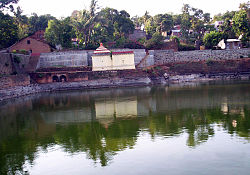Panhala
|
Panhala पन्हाळा |
|
|---|---|
| city | |

Panhala water tank
|
|
| Coordinates: 16°49′N 74°07′E / 16.82°N 74.12°ECoordinates: 16°49′N 74°07′E / 16.82°N 74.12°E | |
| Country | India |
| State | Maharashtra |
| District | Kolhapur |
| Elevation | 754 m (2,474 ft) |
| Population (2001) | |
| • Total | 3,450 |
| Languages | |
| • Official | Marathi |
| Time zone | IST (UTC+5:30) |
| Vehicle registration | MH-09 |
Panhala is a city and a Hill station Municipal Council (3177 feet above sea level) 18 km northwest of Kolhapur, in Kolhapur district in the Indian state of Maharashtra. Panhala is the smallest city in Maharashtra and being a Municipal Council the city is developing rapidly. The city sprawls in the Panhala fort commands a panoramic view of the valley below. The main historical attraction here is the Panhala fort. There are many places of interest, each with its share of haunting anecdotes.
The history of Panhala is closely linked with the history of the Maratha empire, and with its founder, Shivaji. Panhala is the only fort where Shivaji spent more than 500 days, other than his childhood homes. It was Maratha State capital until 1782 and in 1827 it became part of the British Empire.
This imposing fort, 20 km northwest of Kolhapur, is built on an outlying spur of the Sahyadris, rising more than 400 m above plain, and is the largest of all the Deccan forts. The strategic importance of Panhala, guarding one of the principal routes through the Western Ghat, can be judged from its long and varied history. Built between 1178 and 1209, it first served as the headquarters of the Shilahara ruler Bhoja II, and subsequently passed into hands of the Yadavas. It was a favorite outpost of the Bahamanis of Bidar; Mahmud Gawan, the powerful prime minister, encamped here during the rainy season of 1469. By the beginning of the 16th century Panhala was absorbed into the kingdom of Bijapur. The Adil Shahis were responsible for strengthening and rebuilding the ramparts and gateways. The fort was raided by Shivaji in 1659, but it was not until 1673 that he was able to occupy it permanently.
...
Wikipedia

